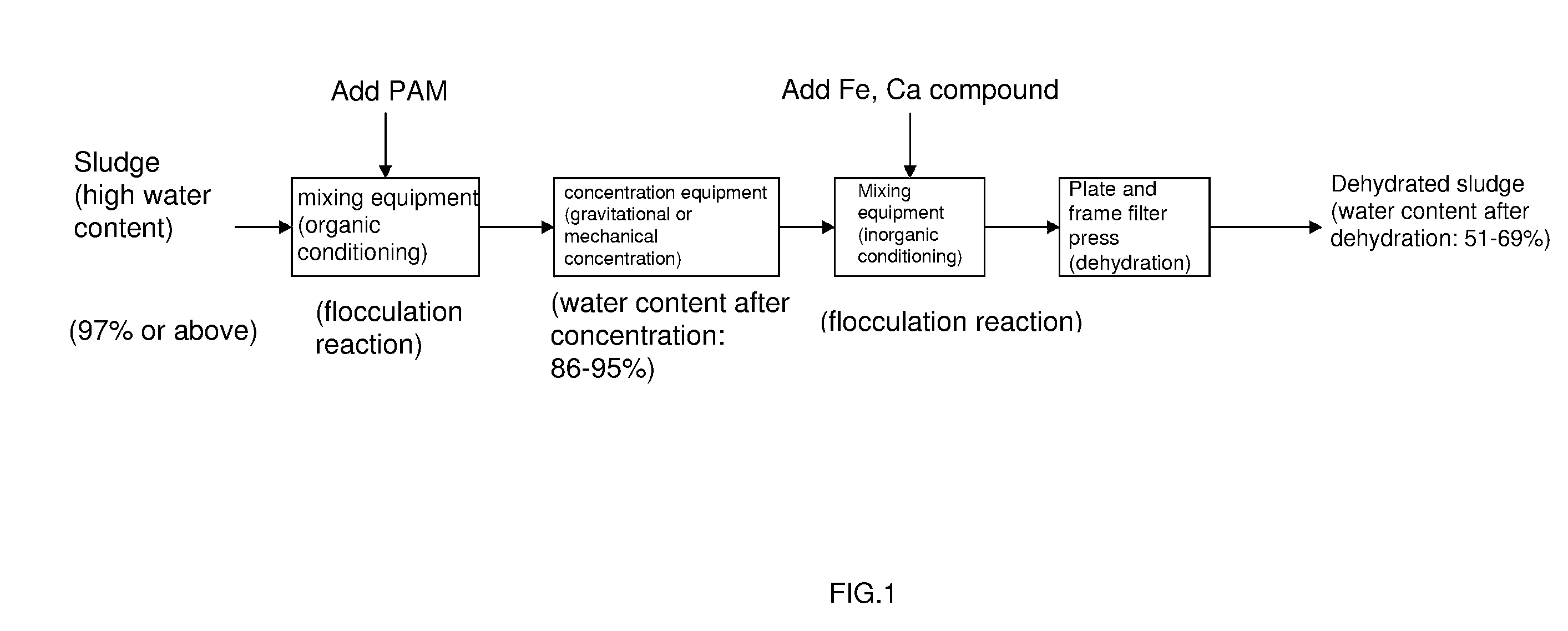Sludge concentration and dehydration method
a technology of sludge concentration and dehydration method, which is applied in water/sewage treatment by ion exchange, separation processes, filtration separation, etc., can solve the problems of long concentration time, difficult to be received by landfills, and the water content of dehydrating sludge cannot be lowered to the optimal level, so as to reduce the size and mass of sludge, reduce the water content, and reduce the size of sludg
- Summary
- Abstract
- Description
- Claims
- Application Information
AI Technical Summary
Benefits of technology
Problems solved by technology
Method used
Image
Examples
embodiment 1
[0022]Transport the remaining sludge with a water content of 99.5% from a secondary sedimentation tank of an urban sewage treatment plant to a mixing tank, add to the sludge with an amount of polyacrylamide (PAM) equivalent to 0.12% of the mass of dry sludge, mix and blend the sludge with polyacrylamide (PAM) for full flocculation reaction to achieve the initial conditioning of the sludge, transport the conditioned sludge to a sludge concentration tank for sedimentation under gravitational force to undergo quick concentration, leave the sludge for 60 minutes for concentration, drain away the supernatant fluid formed by the water separated from the sludge out of the sludge concentration tank, pump the concentrated sludge from the bottom of the concentration tank and transport the concentrated sludge to the next procedure. Concentrated sludge at this stage contains 93% of water.
[0023]Next, the concentrated sludge is transported to a mixing tank for the further conditioning; add 1.9% o...
embodiment 2
[0024]Transport the remaining sludge with a water content of 99.7% from a secondary sedimentation tank of an urban sewage treatment plant to a mixing tank, add to the sludge with an amount of polyacrylamide (PAM) equivalent to 0.15% of the mass of dry sludge, mix and blend the sludge with polyacrylamide (PAM) for full flocculation reaction to achieve the initial conditioning of the sludge, transport the conditioned sludge to a sludge concentration tank for sedimentation under gravitational force to undergo quick concentration, leave the sludge for 120 minutes for concentration, drain away the supernatant fluid formed by the water separated from the sludge out of the sludge concentration tank, pump the concentrated sludge from the bottom of the concentration tank and transport the concentrated sludge to the next procedure. Concentrated sludge at this stage contains 90% of water.
[0025]Next, the concentrated sludge is transported to a mixing tank for the further conditioning; add 2.28%...
embodiment 3
[0026]Transport the remaining sludge with a water content of 99.3% from a secondary sedimentation tank of an urban sewage treatment plant to a mixing tank, add to the sludge with an amount of polyacrylamide (PAM) equivalent to 0.16% of the mass of dry sludge, mix and blend the sludge with polyacrylamide (PAM) for full flocculation reaction to achieve the initial conditioning of the sludge, transport the conditioned sludge to a sludge concentration tank for sedimentation under gravitational force to undergo quick concentration, leave the sludge for 120 minutes for concentration, drain away the supernatant fluid formed by the water separated from the sludge out of the sludge concentration tank, pump the concentrated sludge from the bottom of the concentration tank and transport the concentrated sludge to the next procedure. Concentrated sludge at this stage contains 90.7% of water.
[0027]Next, the concentrated sludge is transported to a mixing tank for the further conditioning; add 2.0...
PUM
| Property | Measurement | Unit |
|---|---|---|
| Fraction | aaaaa | aaaaa |
| Fraction | aaaaa | aaaaa |
| Fraction | aaaaa | aaaaa |
Abstract
Description
Claims
Application Information
 Login to View More
Login to View More - R&D
- Intellectual Property
- Life Sciences
- Materials
- Tech Scout
- Unparalleled Data Quality
- Higher Quality Content
- 60% Fewer Hallucinations
Browse by: Latest US Patents, China's latest patents, Technical Efficacy Thesaurus, Application Domain, Technology Topic, Popular Technical Reports.
© 2025 PatSnap. All rights reserved.Legal|Privacy policy|Modern Slavery Act Transparency Statement|Sitemap|About US| Contact US: help@patsnap.com


